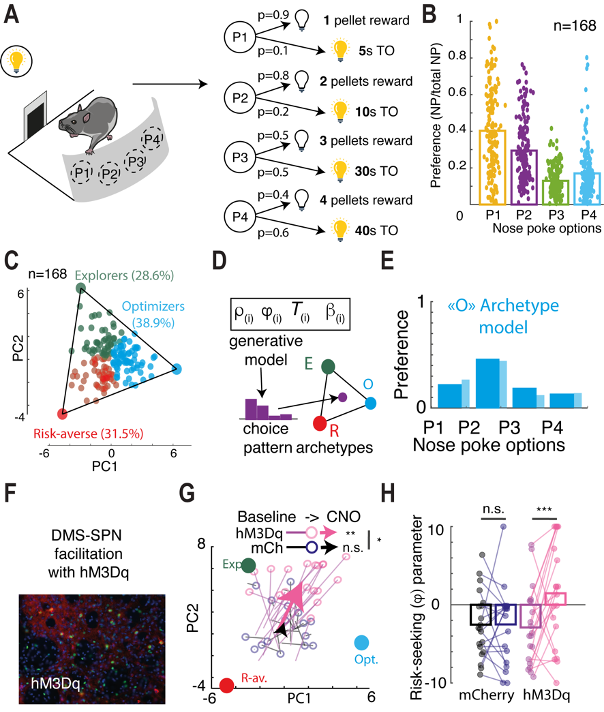In a ground-breaking study, Jérémie Naudé in the team “Pathophysiology of synaptic transmission” led by Julie Perroy, and the team led by Alban de Kerchove d’Exaerde of the ULB Neuroscience Institute have uncovered the neural mechanisms of decision-making, revealing how the brain makes choices by anticipating their consequences. Decision-making involves predicting the probability of different outcomes and estimating their respective values, based on possible gains and losses (and therefore risk).
The striatum, a major subcortical nucleus of the mesocorticolimbic loop, is heavily involved in motor, cognitive and emotional behavior. It is divided into several subregions, including the dorsal striatum, involved in motor and cognitive control, and the nucleus accumbens (NAc), associated with motivation and reward. The study highlights the importance of two types of striatal projection neurons (SPNs): direct pathway SPNs expressing the dopamine D1 receptor (dSPN) and indirect pathway SPNs expressing the dopamine D2 receptor (iSPN). The researchers wanted to understand how these different areas of the striatum affected the calculations underlying decision-making.
By adapting a classic psychology test (“Iowa game”) to rodents, the researchers distinguished three major cognitive profiles in mice: 1) Explorers, attracted by novelty and more inclined to take risks, 2) Risk averse, preferring safe choices, 3) Optimizers, capable of finding a balance between risk and reward to maximize their gains. The researchers then showed that these profiles emerge from different ways of calculating rewards and risk. Thanks to a chemogenetic approach targeting dSPNs and iSPNs, the team was able to modulate the excitability of these neurons and observe the effects on decision-making strategies. On the one hand, increased excitability of dSPNs in the dorsal striatum reduced risk aversion, irrespective of the initial profiles of the mice. On the other hand, changes in iSPN activation have more subtle effects based on reward calculation, modulating behavior according to the initial cognitive profile.
These findings offer valuable insights into the brain mechanisms that underpin our day-to-day decisions. They also provide information on how different substances, such as caffeine and cocaine, can affect individuals according to their decision-making traits. This research also opens the way to new therapeutic avenues for behavioral disorders such as addictions or impulsivity control disorders.
This work has just been published in the journal Science Advances.

A. Adaptation of the “Iowa Gambling Task” to rodents with four choices that differ in terms of number of rewards and risk of punishment (time-out, TO). B. The choices of the four options for all animals in the study show high but consistent variability. C. Archetypal analysis shows the existence of three cognitive profiles: Explorers, Optimizers and Risk-averse. D. A computational decision model generates choices according to sensitivity to reward, punishment and risk. E. This computational model reproduces the different cognitive profiles. F. Subpopulations of the striatum (here neurons of the dorsomedial striatum direct pathway, DMS-SPN) have their activity facilitated by chemogenetics (DREADD hM3Dq and CNO injection). G. Facilitation changes the cognitive profile of mice. H. The change in decision profile is explained by the modification of a parameter in the decision model.


